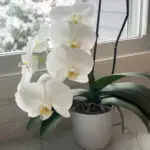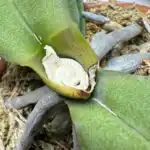Some of the links in this post may be affiliate links.
This simple guide to fertilizing Phalaenopsis orchids will answer your main questions about when, if, and how to fertilize your plants. While you may have heard stories of people saying “I’ve never fertilized my orchids and they’re doing great,” it should be a part of your orchid care routine if you want your plants to reach their true potential.

Table of Contents
FERTILIZING PHALAENOPSIS ORCHIDS
1. When to Fertilize
As a general rule, you can fertilize your moth orchid anytime it is actively growing. For example, I personally like to fertilize starting from about late Winter or so, and through all of Spring, Summer and early Fall.
From mid-Fall through mid-winter or so, I typically either stop or greatly reduce both the frequency and concentration. More on this in the “how to fertilize” section later in this post.
2. When NOT to Fertilize
You should never fertilize to make up for poor cultural conditions. If your plant is not showing any visible signs of growth, and hasn’t been growing for a long time, look to increase your light first, and make sure that you’re watering your orchids properly and keeping them sufficiently hydrated.
With proper light and watering, there is no reason that your orchid should not be growing new roots, leaves and even new flowers. Think of fertilization as supplying your orchids with their regular “vitamins”, but they will utilize light and water to help them manufacture their “food” through photosynthesis.
Also, if you have a wrinkled orchid or one whose root system has been damaged (and these often go hand in hand), work on rehabilitating your plant first before fertilizing it, regardless of the time of year. Once you see your plant start to perk up, you can apply fertilizer.
3. How to Fertilize
Phalaenopsis orchids are not heavy feeders, but they do benefit from regular fertilization. This will not only help avoid nutrient deficiencies, but will also promote more vigorous plants and flowering. The topic of fertilizing orchids can get very complicated, but the basics here are really all you need.
While there are many fertilizers out there that you can use, I wanted to share ones that I’ve personally used and have had success with, including details of usage.
Matching up your fertilizer with the type of water that you use is an important consideration. I go into a lot of these details in my online orchid care course Become an Orchid Master, but here are some basics.
Tap Water
If you’re using tap water to water your orchids (yes I know…you may have heard to completely avoid tap water for orchids), but in many municipalities, the water quality may just be totally fine. In general, orchids like purer water and do not like very hard water, but my tap water quality where I live is actually quite good and not horribly high in TDS (total dissolved solids).
If you are using tap water, I recommend using Orchid Plus fertilizer (link to Amazon). This fertilizer does not have any added calcium (but tap water does contain it), so it’s a perfect match. I’ve also found that it is quite inexpensive compared to many other fertilizers, and it is also endorsed by the American Orchid Society.

The instructions say to add 1 teaspoon per gallon of water, but I usually dissolve about half a teaspoon per gallon of water throughout the growing season. You can use this every single time you water because it’s pretty dilute. And maybe every month or so, you can flush your pot with just plain water with no fertilizer added in order to flush out any accumulated fertilizer salts.
And in the depths of winter, when your orchid my not be growing much at all, you can either eliminate fertilizer, or use perhaps 1/4 teaspoon per gallon of water maybe once a month, until your plant starts growing again.
There are other wintertime considerations other than fertilizer, so check out my post on orchid care tips for winter for more details.
If you have a water softening unit in your home, these units add sodium to your water, which is toxic for plants and is not recommended to use for your plants.
Pure Waters
If you are using distilled water, rain water, or RO (reverse osmosis water), you need a complete fertilizer. (Orchid Plus does not contain calcium and thus is not a complete fertilizer, but it’s fine since you would use that one only with tap water which does contain calcium).
For purer waters, you can use a fertilizer like Orchid Pro which is a complete fertilizer and contains all the necessary nutrients. The label of this fertilizer has changed since I took the photo below, but the formulation is sitll the same.

The label indicates using 1/4-1/2 teaspoon of fertilizer per gallon of water everytime you water. You can follow a similar watering/fertilizing process as what I described with the previous fertilizer.
The gold standard of fertilizer for pure water, however, is the MSU formulation. Although more expensive than Orchid Pro, it is well worth the additional cost. If you are using distilled water, Reverse Osmosis water, or rainwater, try out Feed Me! orchid fertilizer (link to Amazon) from rePotme.
I recommend picking one, and use it for at least a year as a part of your orchid care routine and see how you like it. You can also switch and experiment to see what you like best.
Routinely using a good fertilizer will result in more vigorous plants in the long term, and avoid nutrient deficiencies that can stunt your plant’s growth.
If you want to learn all about how to get your orchid to rebloom reliably and have healthy, thriving moth orchid plants, don’t miss my signature, online orchid care course, Become an Orchid Master. It also includes bonuses with support from me, personally, to guide you in your orchid journey!







Laura C
Monday 21st of July 2025
Yes it’s me again. My orchids are grown in artificial light. And I have burned some of them. And some only have a few red stained leaves left. I changed the amount of light they are getting. I keeping them at 60 par and cut off any flower spikes as they start to grow but is there more I can do to get more leaf growth? And thank you in advance.
Raffaele Di Lallo
Tuesday 22nd of July 2025
Hi Laura! Sorry to hear about the leaves burning. It helps to invest in a light meter as this helps tremendously (and it's fun to play with). Other than normal care, there are no magic tricks. Just continue with providing good light, a consistent watering routine and fertilization. And most importantly, have patience. The new leaves will grow in just fine at this point and they will eventually mask the damaged leaves.
Laura C
Wednesday 28th of May 2025
May 27,2025
Hi Rafael,
Your information is always correct and thanks for sharing it with us. But May I ask a question? Should orchids be fertilized while flowering? Oh and your Orchid Master class is so helpful. Worth every penny.
Raffaele Di Lallo
Thursday 29th of May 2025
I'm so happy that you enjoyed the course Laura! That's a great question about fertilizing. Some people will tell you that you shouldn't. But if you fertilize very dilutely like I recommend, I personally have not seen any problems at all with doing so. If you are worried, you can maybe do half the concentration of what you'd normally do.
Kay Bona
Saturday 26th of April 2025
Hi Raffaele,
I love reading your articles and you have helped me and my orchids in so many ways! I appreciate it. About the fertilizer, a few weeks ago I read your article on growing orchids in clay balls and I started one of mine growing that way. So my question is how do I fertilize it, and how do I go about flushing it out? Since it is in a glass vase now, there are no vents for me to run water through.
Raffaele Di Lallo
Sunday 27th of April 2025
Hi Kay! You can just let it soak in fertilizer solution for a few minutes and then dump it out. As far as flushing, you can just do it the same way but with just plain water (maybe distilled for flushing). Hope this helps a bit.
Denise Konnik
Wednesday 16th of April 2025
Hi Carmen. I enjoy reading everything you share with us orchid lovers. . I have a concern: how do I water my orchids with a 2 week vacation coming up? Denise Konnik
Raffaele Di Lallo
Wednesday 16th of April 2025
Hi Denise. Is it in moss or bark? If it's in bark, I would just give it a reallygood soaking (even for an hour) and then drain all the excess water out. Your plant will be fine. You may also want to put it out of any direct sun if it is currently getting some direct sun. This will help it not dry out as quickly while you are gone. It will be totally fine for two weeks if you do this. If you have it in sphagnum moss, just give it a good top watering right before you leave. Hope this helps a bit?
Usha Menon
Tuesday 15th of April 2025
Like the article very much. Very helpful.
Raffaele Di Lallo
Tuesday 15th of April 2025
I'm glad that you enjoyed it Usha!